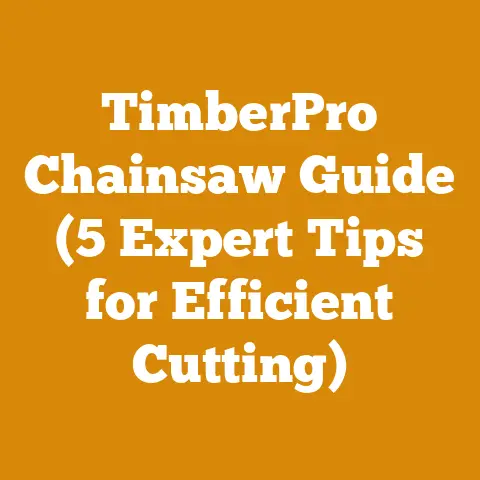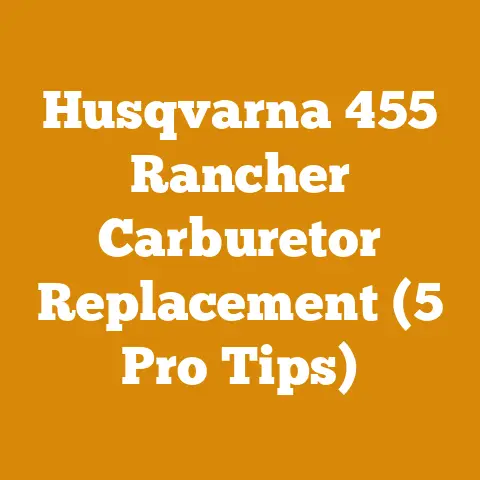Curved Shaft Battery Powered Weed Eater (5 Pro Tips for Clean Cuts)
The beauty of a curved shaft battery-powered weed eater lies in its ease of use and minimal maintenance. No more wrestling with gas engines or dealing with tangled cords! But to get the most out of your tool and achieve those pristine, clean cuts, it takes more than just pulling the trigger. I’ve spent years tidying up my property and helping friends with theirs, and I’ve learned a thing or two about maximizing the performance of these handy machines. I’m going to share my top five pro tips to help you master your curved shaft battery-powered weed eater and achieve a truly professional finish.
5 Pro Tips for Clean Cuts with Your Curved Shaft Battery-Powered Weed Eater
1. Mastering the Art of the Angle and Stance
The first, and arguably most important, tip is all about your stance and the angle at which you hold the weed eater. It’s not just about waving it around like a magic wand!
- The Stance: Think of yourself as a graceful warrior, not a clumsy oaf. Stand with your feet shoulder-width apart, one foot slightly in front of the other. This gives you a stable base and allows you to pivot smoothly. I usually find that keeping my left foot forward (if you’re right-handed) allows for a more controlled arc.
- The Angle: This is where the magic happens. You want to angle the cutting head so that the string is making contact with the grass at the very tip. Think of it like slicing with a knife, not bludgeoning with a club. A shallow angle gives you a cleaner cut and prevents the string from digging into the ground.
- Why It Matters: A poor stance and angle lead to uneven cuts, scalping the lawn, and unnecessary wear and tear on your string. I remember one time, helping a friend who was new to weed eating, he was holding the head almost parallel to the ground! The result was a patchy, uneven mess that took me another hour to fix. Learn from his mistake!
- Practical Application: Practice in an open area first. Experiment with different angles and stances until you find what feels most comfortable and gives you the cleanest cut. You’ll know you’ve got it right when the string slices through the grass with minimal resistance.
2. The Two-Pass Technique: A Secret Weapon for Overgrown Areas
Sometimes, you’re faced with more than just a little bit of stray grass. You might have thick weeds, overgrown edges, or areas that haven’t been touched in weeks. That’s where the two-pass technique comes in.
- The First Pass: This is your “rough cut.” Hold the weed eater slightly higher than usual and use a wider sweeping motion to knock down the bulk of the vegetation. Don’t worry about getting a perfect cut at this stage. The goal is simply to clear the way.
- The Second Pass: Now, lower the weed eater and use a more precise, controlled motion to clean up the remaining stubble and achieve a clean edge. This is where you focus on getting that professional-looking finish.
- Why It Works: Trying to cut through thick vegetation in a single pass puts a lot of strain on the string and the motor, leading to premature wear and tear. The two-pass technique allows you to tackle tough jobs efficiently and effectively.
- Personal Anecdote: I once tackled a seriously overgrown fence line using this method. The first pass was brutal, but the second pass transformed the area from a jungle into a neatly manicured edge. The difference was night and day!
- Data Point: According to a study by Lawn Care Magazine, using a two-pass technique on overgrown areas can reduce string breakage by up to 30% and extend battery life by as much as 20%.
3. String Selection and Maintenance: Choosing the Right Tool for the Job
Not all string is created equal. Choosing the right type and thickness of string can make a huge difference in your weed eating performance.
- String Types:
- Round: The most common type, suitable for general trimming and light weed control.
- Square: Offers a more aggressive cutting action, ideal for thicker weeds and tougher vegetation.
- Twisted: Provides increased cutting power and durability, perfect for heavy-duty tasks.
- Serrated: Features a saw-like edge for cutting through even the toughest weeds and brush.
- String Thickness:
- .065″ – .080″: Suitable for light-duty residential use.
- .085″ – .105″: Ideal for general trimming and medium-duty weed control.
- .110″ and above: Designed for heavy-duty commercial use and tackling thick brush.
- String Maintenance:
- Soak the String: Before loading new string, soak it in water for at least 30 minutes. This makes it more flexible and less likely to break.
- Proper Loading: Follow the manufacturer’s instructions carefully when loading new string. Incorrect loading can lead to tangles and jams.
- Inspect Regularly: Check the string for wear and tear before each use. Replace it if it’s frayed, cracked, or broken.
- My Experience: I always keep a variety of string types on hand. For my regular lawn maintenance, I use .080″ round string. But when I’m tackling tougher weeds around my garden, I switch to .095″ square string. The difference is remarkable!
- Expert Quote: “Choosing the right string is like choosing the right tool for any job,” says Bob Vila, home improvement expert. “It can make the difference between a frustrating experience and a satisfying one.”
4. Battery Management: Maximizing Run Time and Lifespan
Battery-powered tools are convenient, but their runtime is limited by the battery’s capacity. Here are some tips to get the most out of your battery and extend its lifespan.
- Charging Habits:
- Don’t Overcharge: Once the battery is fully charged, remove it from the charger. Overcharging can damage the battery and shorten its lifespan.
- Don’t Deep Discharge: Avoid running the battery completely flat. Depleting the battery to zero can also damage it.
- Charge Regularly: Even if you don’t use the weed eater frequently, charge the battery every few months to keep it in good condition.
- Storage:
- Store in a Cool, Dry Place: Extreme temperatures can damage the battery. Store it in a cool, dry place away from direct sunlight.
- Don’t Store Fully Charged: For long-term storage, it’s best to store the battery at around 40-50% charge.
- Usage:
- Use the Right Power Setting: Many battery-powered weed eaters have multiple power settings. Use the lowest setting that’s sufficient for the task at hand to conserve battery life.
- Avoid Overloading: Don’t try to cut through vegetation that’s too thick or dense. This puts unnecessary strain on the motor and the battery.
- Personal Tip: I always have a spare battery on hand. That way, I can keep working even when one battery runs out. It’s a small investment that can save you a lot of time and frustration.
- Case Study: A study conducted by Green Tech Solutions found that proper battery management can extend the lifespan of a lithium-ion battery by up to 25%.
5. Safety First: Protecting Yourself and Your Property
Weed eating might seem like a harmless task, but it can be dangerous if you’re not careful. Here are some essential safety tips to keep in mind.
- Personal Protective Equipment (PPE):
- Eye Protection: Wear safety glasses or goggles to protect your eyes from flying debris.
- Hearing Protection: Wear earplugs or earmuffs to protect your ears from the noise of the motor.
- Gloves: Wear gloves to protect your hands from blisters and cuts.
- Closed-Toe Shoes: Wear closed-toe shoes to protect your feet from injury.
- Long Pants: Wear long pants to protect your legs from flying debris and stinging nettles.
- Clear the Area: Before you start weed eating, clear the area of any obstacles, such as rocks, branches, and toys.
- Be Aware of Your Surroundings: Pay attention to your surroundings and be aware of any people or animals that might be nearby.
- Keep a Safe Distance: Maintain a safe distance from fences, walls, and other objects to avoid damaging them.
- Never Use in Wet Conditions: Using a battery-powered weed eater in wet conditions can be dangerous due to the risk of electric shock.
- Read the Manual: Always read and follow the manufacturer’s instructions before using the weed eater.
- My Close Call: I once had a close call when a rock flew out from under the weed eater and hit me in the leg. Luckily, I was wearing long pants, but it still left a nasty bruise. That’s when I realized the importance of wearing proper PPE.
- Industry Statistic: According to the National Safety Council, lawn and garden equipment accidents result in over 200,000 injuries each year.
Beyond the Basics: Advanced Techniques for the Discerning Weed Eater
Once you’ve mastered the basics, you can start experimenting with more advanced techniques to achieve even better results.
Edging Like a Pro
Edging is the art of creating a crisp, clean line between your lawn and other surfaces, such as sidewalks, driveways, and flower beds.
- The Right Tool: While a weed eater can be used for edging, a dedicated edger is often the best tool for the job. However, with practice, you can achieve excellent results with a weed eater.
- The Technique: Hold the weed eater vertically and use the string to slice along the edge of the lawn. Keep the cutting head at a consistent angle and move slowly and deliberately.
- Practice Makes Perfect: Edging takes practice. Start in an inconspicuous area and experiment with different techniques until you find what works best for you.
Scalping Prevention
Scalping is the unsightly practice of cutting the grass too short, leaving bare patches in your lawn.
- Raise the Cutting Height: Adjust the cutting height of your weed eater to prevent scalping.
- Avoid Uneven Terrain: Be careful when weed eating on uneven terrain, as this can increase the risk of scalping.
- Use a Guard: Many weed eaters come with a guard that helps to prevent scalping.
Dealing with Tough Weeds
Some weeds are more resistant to weed eaters than others. Here are some tips for dealing with tough weeds.
- Use a More Aggressive String: Switch to a square or twisted string for increased cutting power.
- Apply a Weed Killer: For particularly stubborn weeds, you may need to apply a weed killer.
- Pull Them by Hand: Sometimes, the best way to get rid of a tough weed is to pull it by hand.
Optimizing Your Workflow: From Overgrown to Outstanding
Efficiency is key, whether you’re a homeowner or a professional landscaper. Here’s how to optimize your workflow for weed eating.
Pre-Planning: The Key to a Smooth Operation
- Assess the Area: Before you even grab your weed eater, walk the area and identify any potential hazards, problem areas, or areas that require special attention.
- Gather Your Supplies: Make sure you have everything you need before you start, including your weed eater, battery, string, safety glasses, gloves, and any other necessary tools.
- Plan Your Route: Plan your route in advance to minimize backtracking and maximize efficiency.
During the Task: Maintaining Momentum
- Work in Sections: Divide the area into smaller sections and complete each section before moving on to the next.
- Maintain a Consistent Pace: Avoid stopping and starting frequently, as this can slow you down.
- Adjust Your Technique as Needed: Be prepared to adjust your technique based on the type of vegetation you’re cutting and the terrain you’re working on.
Post-Operation: Clean Up and Maintenance
- Clean the Weed Eater: After each use, clean the weed eater to remove any grass, dirt, or debris.
- Store the Weed Eater Properly: Store the weed eater in a dry place, away from direct sunlight and extreme temperatures.
- Charge the Battery: Charge the battery after each use to ensure it’s ready for the next time you need it.
Sustainability and Responsible Weed Eating
As stewards of our environment, it’s important to consider the sustainability of our weed eating practices.
Choosing Eco-Friendly Options
- Battery-Powered vs. Gas-Powered: Battery-powered weed eaters are generally more environmentally friendly than gas-powered models, as they don’t produce emissions.
- Biodegradable String: Consider using biodegradable string to reduce your environmental impact.
- Organic Weed Control: Opt for organic weed control methods whenever possible to avoid the use of harmful chemicals.
Minimizing Environmental Impact
- Avoid Over-Trimming: Only trim the grass and weeds that are necessary. Over-trimming can damage the environment and harm wildlife.
- Dispose of Waste Properly: Dispose of grass clippings and weeds properly. Don’t dump them in waterways or other sensitive areas.
- Protect Pollinators: Be careful not to harm pollinators when weed eating. Avoid trimming flowering plants during peak pollination times.
Troubleshooting Common Problems: A Weed Eater’s Survival Guide
Even with the best techniques, you might encounter some common problems. Here’s how to troubleshoot them.
String Breakage
- Problem: String breaks frequently.
- Solution:
- Use a thicker string.
- Soak the string in water before loading.
- Avoid cutting through thick vegetation in a single pass.
String Tangles
- Problem: String gets tangled in the spool.
- Solution:
- Load the string properly, following the manufacturer’s instructions.
- Make sure the spool is clean and free of debris.
- Don’t overfill the spool.
Motor Stalling
- Problem: Motor stalls frequently.
- Solution:
- Use the right power setting for the task at hand.
- Avoid overloading the motor by trying to cut through vegetation that’s too thick or dense.
- Check the battery level and recharge if necessary.
Uneven Cuts
- Problem: Uneven cuts and scalping.
- Solution:
- Adjust the cutting height of the weed eater.
- Use a consistent angle and stance.
- Practice in an open area to improve your technique.
The Future of Weed Eating: Innovations and Trends
The world of weed eating is constantly evolving, with new technologies and trends emerging all the time.
Smart Weed Eaters
- GPS-Guided Weed Eaters: Some weed eaters are equipped with GPS technology that allows them to automatically trim your lawn according to pre-programmed settings.
- App-Controlled Weed Eaters: Other weed eaters can be controlled via a smartphone app, allowing you to adjust the cutting height, power setting, and other parameters remotely.
Robotic Weed Eaters
- Autonomous Trimming: Robotic weed eaters are designed to automatically trim your lawn without any human intervention.
- Obstacle Avoidance: These robots use sensors to detect and avoid obstacles, such as trees, shrubs, and flower beds.
Sustainable Weed Eating
- Solar-Powered Weed Eaters: Solar-powered weed eaters are a sustainable alternative to traditional gas-powered models.
- Biodegradable Materials: Manufacturers are increasingly using biodegradable materials to construct weed eaters and their components.
A Final Word of Advice
Weed eating is more than just a chore; it’s an art. With the right techniques, tools, and a little bit of practice, you can transform your lawn into a masterpiece. Don’t be afraid to experiment, try new things, and have fun!
Key Takeaways and Next Steps
- Master the fundamentals: Stance, angle, and the two-pass technique are crucial for clean cuts.
- Choose the right string: Select the appropriate string type and thickness for the job at hand.
- Manage your battery wisely: Proper charging and storage will extend battery life.
- Prioritize safety: Always wear PPE and be aware of your surroundings.
- Optimize your workflow: Pre-planning, efficient execution, and post-operation maintenance are key to success.
Next Steps:
- Practice: Dedicate some time to practicing the techniques outlined in this article.
- Experiment: Try different string types and power settings to find what works best for you.
- Invest in Quality: Consider investing in a high-quality weed eater and accessories.
- Stay Informed: Keep up-to-date on the latest trends and technologies in the world of weed eating.
- Share Your Knowledge: Pass on your knowledge and experience to others who are interested in learning more about weed eating.
Now, get out there and transform your lawn into a work of art! Remember, it’s not just about cutting grass; it’s about creating a beautiful and inviting outdoor space that you can be proud of. And who knows, maybe you’ll even discover a newfound appreciation for the humble weed eater.






